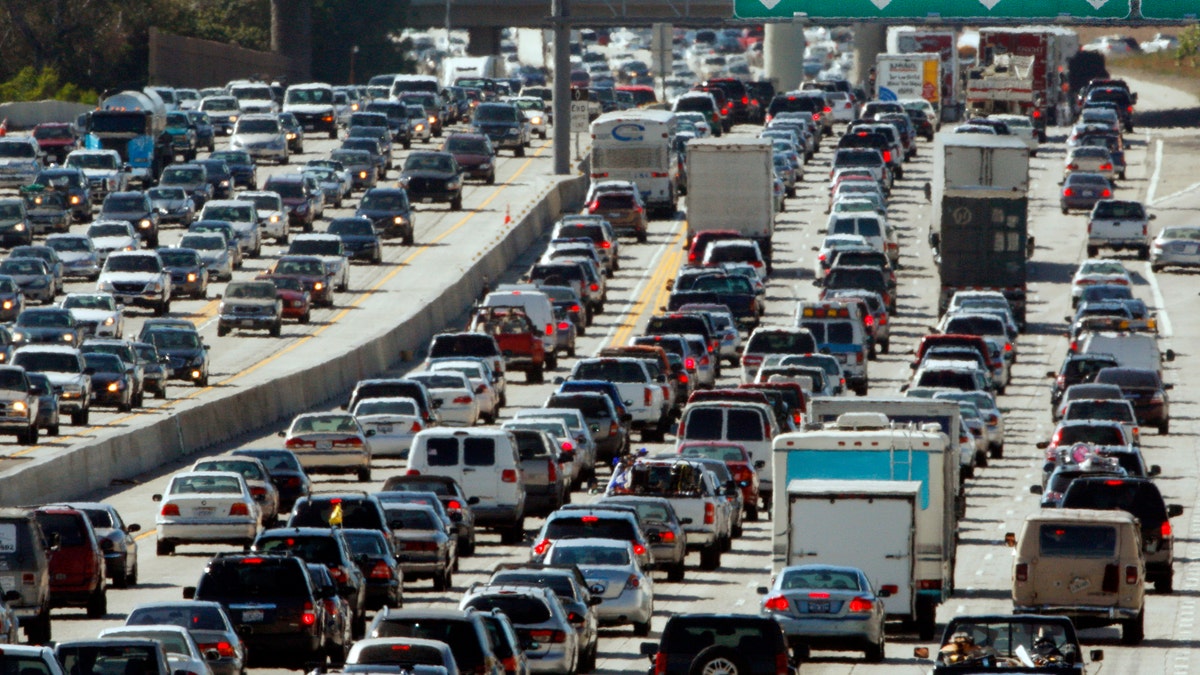
More Americans will hit the road this holiday weekend than a year ago. (AP2010)
NEW YORK – More Americans will hit the road this holiday weekend than a year ago. And they'll have a bit more money to spend thanks to lower gas prices.
Memorial Day kicks off the summer travel season, and since pump prices never reached $4 or $5 a gallon, as feared, economists says travelers are likely to dine out or shop more once they pull off the road.
About 30.7 million people will drive more than 50 miles for Memorial Day trips, according to auto club AAA. That's 400,000 more than last year, a jump AAA attributes to improvement in the economy and consumer attitudes. The number of holiday travelers grows to 34.8 million when you include planes, trains and other means of transportation.
A drop in gas prices encouraged Americans to spend more at restaurants and bars in April. And that trend could continue over the holiday. Pump prices are down 27 cents since their peak in early April, to $3.67 a gallon, where they're likely to stay this weekend, predicts Tom Kloza, the chief oil analyst at the Oil Price Information Service. That's 12 cents cheaper than last year. Over the weekend, U.S. drivers will burn about 1.2 billion gallons of gasoline — and spend $144 million less on gas than last year.
Restaurants, movie theaters and retailers hope some of that savings goes to them. Just last month, AAA and IHS Global Insight, the firm that analyzed the AAA study, were expecting travelers to spend less on entertainment, dining and shopping on vacation and devote more time to family and friends. .
Now, travelers might take longer trips or spend more on other things "because there's more money left in their pocket," says John Larson, vice president for IHS.
Still, most people need to restrict their travel budgets. For many, incomes are growing slightly if at all. Household debt remains high. And although the increase in the stock market over the past year has helped some regain wealth lost in the recession, there is still a ways to go. A recent report from the Federal Reserve shows that American household wealth would have to rise by 13 percent to return to pre-recession levels.
While drivers may feel relief at the pump, gas still isn't cheap. Besides last year, the only other time gas was more expensive on Memorial Day was 2008, when it eventually climbed to a record of $4.11 per gallon. This year, gas shot up by 66 cents from January through early April because of a spike in oil prices.
As a result, many people were skittish about planning long road trips. Half of those surveyed by AAA said they'll travel less than 400 miles. They might be tempted to drive farther — a fill up costs about $4 to $5 less than in early April when gas peaked at an average of $3.94. But they'll burn through that savings after about 30 to 40 miles.
Douglas Berkley, Jr., of Cranberry Township, Pa. drives his family 90 miles to a family house on Indian Lake in Shanksville, Pa. most summer weekends, including Memorial Day. He hasn't noticed much of a drop in prices — it still costs him about $80 to fill his Chevy Tahoe. "Any little bit helps, though, obviously," he says.
How far people travel might also depend on where they live. The difference in gas prices around the country is far wider than normal this year, Kloza says. In states like South Carolina, drivers could be paying as low as $3.10. Meanwhile, refinery problems on the West Coast — where prices usually exceed the national average anyway — have kept prices especially high there. West Coast drivers could be paying as much as $4.50 per gallon this weekend.
Thom Rasmussen of Battle Ground, Wash. would have driven 100 miles southwest to Lincoln City, Oregon and rented a hotel near the coast. Except that gas has risen to $4.33 per gallon where he lives. The retired truck maker now plans to "rent a bunch of movies" with his wife. He'll consider making the trip this summer if gas falls below $4.
Some people who would normally stuff suitcases in overhead bins are packing them in car trunks. They're balking at higher ticket prices, and AAA forecasts a 5.5 percent decline in air travel within the U.S. this Memorial Day. U.S. airlines spent 8 percent more on fuel in the first quarter, on top of a 26 percent increase last year, government data show. They're passing that expense along to passengers.
The average airfare for North American flights: $291.04 per round trip, including taxes, according to travel site Kayark.com. That's up 23 percent from last year.
Memorial Day travel is usually a good proxy for the summer. Alan Pisarski, independent consultant for the tourism industry, expects summer travel to be about flat compared with last year. Pisarski says concerns about the economy, primarily about jobs and housing, will keep many people at home. Others will likely travel less than they'd planned.
Douglas Frechtling, chair of the Department of Tourism and Hospitality Management at George Washington University, is more optimistic. He thinks the drop in unemployment, higher incomes and the drop in gas prices will encourage more people to travel. The increase will be just a "few" percent. But that's important for travel destinations like Provincetown Mass. on the tip of Cape Cod, and Ocean City, Md., where motels and restaurants were forced to close during the economic downturn.
AAA doesn't expect a significant pick up in travel until employment, incomes and consumer spending show greater gains and the housing market turns around. It sees signs of that happening next year. For now, travel remains well below the pre-recession peak of 2005, when 44 million people traveled for Memorial Day weekend.
At least that's good news for people who hate overcrowded beaches.

